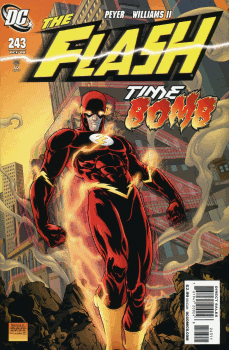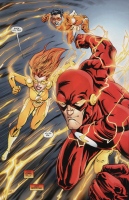
Flash #243 marks the last issue of the Tom Peyer/Freddie Williams II run on the series, and the final issue of the “Fast Money” storyline. It resolves a number of plotlines from the past year, leaving other possibilities open.
 Artist Freddie Williams II has really hit his stride on this book, which makes it a shame that he’s leaving. It took a while to get used to it, but a few issues ago I started to like it. It seemed to have more life, more energy, than it did at first — and in a book that’s all about speed, that’s critical. (Interestingly, when I spoke with him at Comic-Con, he mentioned that the editor had initially insisted on a slightly different style than his usual, and he’d been allowed to go back to his regular style around the same point that I started liking the art. He also had a page of original art from Flash #241 that I would have been seriously tempted by if I’d had a spare $250…)
Artist Freddie Williams II has really hit his stride on this book, which makes it a shame that he’s leaving. It took a while to get used to it, but a few issues ago I started to like it. It seemed to have more life, more energy, than it did at first — and in a book that’s all about speed, that’s critical. (Interestingly, when I spoke with him at Comic-Con, he mentioned that the editor had initially insisted on a slightly different style than his usual, and he’d been allowed to go back to his regular style around the same point that I started liking the art. He also had a page of original art from Flash #241 that I would have been seriously tempted by if I’d had a spare $250…)
Story-wise, I’ve really enjoyed the last three issues (parts 3-5), but I felt that the final chapter fell short. In part, there were three major plot threads to resolve, and only one really got any focus. Additionally, that resolution seemed to hinge on a piece of knowledge which they should already have had.
At this point I’ll have to break into spoilers. You have been warned.
SPOILERS AHEAD
.
.
.
First: Iris and Jai’s fate. This was the most developed thread in this issue. We soon realize that Iris isn’t really dead at the end of last issue, proving that you should never take a cliffhanger death at face value…especially when dealing with a villain who can mess with people’s minds. Over the course of the issue, Wally realizes that their problem is essentially the same one Max Mercury faced during the “Mercury Falling” arc in Impulse: The speed force has been draining them.
I liked that they actually expanded the mythos slightly. Wally hints that the Black Flash is actually a manifestation of one aspect of the speed force — the aspect of death “as in hitting a wall at 120 miles per hour.” That same aspect has been draining years from Iris and Jai’s lives. Wally manages to force that aspect out of them, restoring them to the ages they were at the beginning of the story.
So the twins are back to the status quo from the start of this run, except that now they no longer have to worry about dying of old age overnight. They’re also both still around, old enough to be characters in their own right, and with powers that make them distinct from each other and from short Flashes. It also eliminates one of the supposed inconsistencies that people have been complaining about with Final Crisis and Rogues’ Revenge, which showed both of them alive and young. (Though I’m a bit apprehensive about what may happen to them during Final Crisis.)
What I didn’t like was the the price was too low and the victory too complete. Dramatically, it seemed that it should have cost something — perhaps losing or changing their powers. It also seemed arbitrary that they would end up at physically 8 and 10, rather than their natural age (which should be somewhere between one and two years old) or the ages at which they entered the speed force in this issue.
I also had two problems with the explanation. First, it seemed that Wally and Linda already knew the twins’ connection with the speed force was the problem, not their genes. Maybe I was jumping to conclusions way back in #231, but it seemed obvious. Secondly, this whole storyline has been conflating growth and aging. It doesn’t make any sense that draining a child’s life force would cause her to grow into a teenager and then adult.
Second: Gorilla Grodd. This was wrapped up way too quickly and conveniently. As near as I can tell, Iris phased him out of reality in the space of one panel. In many ways, it’s like Wally turning Inertia into a statue back in All-Flash #1: an immensely powerful trick, and something that can only be used once. It seemed like Peyer was shoving Grodd out of the way to make room for the resolution of the twins’ storyline. Under the circumstances, it wouldn’t surprise me if that was exactly what was happening.
Third: Keystone Hates the Flash. This got a little attention, but was mostly hand-waved away as something that could be dealt with later. Spin himself had already been taken care of earlier in the story.
Conclusion: “Fast Money” had a strong middle, but was wrapped up too hastily to really follow through. I still think that Peyer and Williams could have been a good team on the ongoing title, but DC has decided to go in another direction with the series.

So what are the next steps for Wally before Flash: Rebirth?
Overall I actually liked this issue. I did have some gripes though, and agreed with you on some points. What happened to the Black Flash ‘essence’ that was being torn out of Jai and Iris? It seemed to be entering into Wally… did he take it on knowing he would die, or did it just evaporate?
Agreed on the Grodd part. So where is he? Is he alive or dead? ugh.
Also, I don’t know what they are going to do between now and Rebirth. There is a huge change coming and the build-up of stress is not going to budge. It would be nice if they hinted at what was coming at some point.
I’m becoming a bit dismayed with the turn of the book after the appearance of the twins. I feel like they should have stayed as babies. Things feel too complicated and unfinished right now. I doubt that will change!
I actually prefer the kids to be old enough that they can be supporting characters rather than props. Powers are optional.
Grodd, I’m sure, will be back.
I just got to this issue.
I liked the art, too. There were a number of panels that were just bristling with energy.
I do much prefer the kids as supporting characters rather than simply plot devices. If they weren’t artificially aged, they might’ve remained as toddlers for a long time.
Was there some reason the guy from Keystone at the end couldn’t remember the woman’s name? That was done with purpose but I just don’t know what it was.
.-= Wally East’s latest blog post: Mint Chocolate =-.